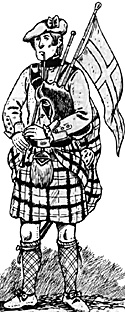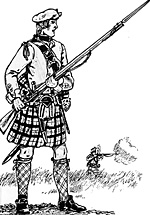 During the Seven Years War the Anglo-German Army
of Ferdinand of Brunswick-Wolfenbuttel brilliantly held
Westphalia against the numerically superior French
Army. Serving with Ferdinand were two Highland
battalions, the 87th Foot (Keith's) and the 88th Foot
(Campbell's). These battalions were later reinforced by the
drafts of a third, the 101st Foot (Johnstone's), and some
men raised by one Maclean.
During the Seven Years War the Anglo-German Army
of Ferdinand of Brunswick-Wolfenbuttel brilliantly held
Westphalia against the numerically superior French
Army. Serving with Ferdinand were two Highland
battalions, the 87th Foot (Keith's) and the 88th Foot
(Campbell's). These battalions were later reinforced by the
drafts of a third, the 101st Foot (Johnstone's), and some
men raised by one Maclean.
The 87th
The 87th was formed in 1759 by Major Robert Murray Keith at Perth. Its strength was three companies of 105 men each. On the fourteenth of November, 1759, the battalion joined Prince Ferdinand at Krodorf, too late for the ghastly march back from Bergen or the glory of Minden.
Keith's men were assigned to the corps commanded by the aggressive Graf zu Luckner and were soon in action. On the third of January near Herborn, a detachment of Ferdinand's Army was besieged in the castle of Dillemburg by the French under the Marquis de Vogue. The Highlanders participated in Prince Ferdinand's counter-attack relieving the garrison. A quoted description of the action is found in Browne, as follows:
- "The Highanders under Major Keith, supported
by the hussars of Luckner, who commanded the whole
detachment, attacked the village of Eybach, where
Beau Fremonte's regiment of dragoons was posted, and
routed them with great slaughter. The greater part of the
regiment was killed, and many prisoners were taken,
together with two hundred horses and all their baggage.
The Highlanders distinguished themselves on this
occasion by their intrepidity, which was the more
remarkable, as they were no other than raw recruits, just
arrived from their own country, and altogether
unacquainted with discipline. "
The Marquis de Granby further wrote that "the Highlanders have been blooded and behaved very well. Major Keith . . . gained great credit." Prince Ferdinand, well satisfied with the conduct of this battalion, requested more of these little fellows. Five hundred more men were soon raised and sent to Major Keith.
The 88th
In addition, another battalion of eight hundred Highlanders was raised and embodied at Stirling. This unit, designated the 88th Foot, was commanded by John Campbell of Dunoon. It arrived in Germany along with the second British contingent on the twenty-ninth of June, 1760. Some of the officers with the regiment were Major Macnab, Captains Archibold Campbell,
The two battalions were given the distinction of being assigned to the brigade of British grenadiers commanded by Colonel Beckwith. They served with this brigade throughout the war, with few exceptions. The grenadier battalion of Major Maxwell consisted of the grenadier companies of the 12th, 20th, 23rd, 25th, 37th and 51st Foot. The battalion formed from the second contingent, succeedingly commanded by Majors Daulhatt, Lennox, Walsh and Eustace, consisted of the grenadier companies of the 5th, 8th, 11th, 24th, 33rd and 50th Foot. Beckwith's brigade drew the toughest assignments from the beginning and was usually found in the van of the army or on detached service.
After the action near Warburg the two Highland battalions were joined by a reinforcement of four hundred men from Johnstone's Highlanders, and soon afterwards by two hundred more raised by Maclean. The men from Johnstone's were not accompanied by their officers who remained to raise another six companies in the Highlands. These additional companies were well uniformed and equipped, but remained at Perth until being disbanded in August of 1762.
The Battle of Vellinghausen
 Both battalions were heavily engaged at the Battle of
Vellinghausen on July 15, 1761. The Highlanders, along
with Sandford's Brigade, were inexplicably surprised by a
French attack in the late afternoon. However, they put up
a stout defense and soon went to the attack. A good
description of the tactics in this rough country is given by
an account describing the Highland attack as swarming
"forward in groups and batches through enclosed country,
rather than in lines." This caught the French disordered.
Both battalions were heavily engaged at the Battle of
Vellinghausen on July 15, 1761. The Highlanders, along
with Sandford's Brigade, were inexplicably surprised by a
French attack in the late afternoon. However, they put up
a stout defense and soon went to the attack. A good
description of the tactics in this rough country is given by
an account describing the Highland attack as swarming
"forward in groups and batches through enclosed country,
rather than in lines." This caught the French disordered.
The Highlanders made quite an impression on the inhabitants of Westphalia, who looked upon these clansmen as "strangers to Christianity". An article in the Vienna Gazette of 1762 reports:
- "The Scotch Highlanders are a people totally
different in their dress, manners, and temper from the
other inhabitants of Britain. They are caught in the
mountains when young, and still run with a surprising
degree of swiftness. As they are strangers to fear, they
make very good soldiers when disciplined.
The men are of low stature, and the most of them old or very young. They discover an extraordinary submission and love for their officers, who are all young and handsome. From the goodness of their dispositions in every thing, for the boors are much better treated by these savages than by the polished French and English; from the goodness of their disposition, which, by the by, shows the rectitude ot human nature betore it is vitiated by example or prejudice, it is to be hoped that their king's laudable, though late, endeavours. to civilize and instruct them in the principles of Christianity will meet with success!"
The article adds, that the 'French held them at first in great contempt, but they have met with them so often of late, and seen them in the front of so many battles, that they firmly believe that there are twelve battalions of them in the arms instead of two. Broglio himself has lately said that he once wished that he was a man of six feet high, but that now he is reconciled to his size since he has seen the wonders performed by the little mountaineers.'"
Uniform
The uniform of the Highlanders serving in Germany was identical (except for the color of the facings) to that of the " Black Watch", with which most wargamers are surely familiar. The kilt and full plaid was worn in the field. The tartan was probably identical to that of the Black Watch which was also known as the "government tartan".
The tartan's basic color is dark green with narrow medium green vertical and horizontal stripes. Over these narrow medium green stripes were pencil-thin black stripes. A good description is given in the cited article by Kevin Hendryx. Pipers and musicians probably wore the Royal Stewart tartan. This is described as "scarlet, with medium stripes of dark green arranged in pairs, the pairs spaced widely apart. Over the green stripes were alternating overstripes of yellow and white."
From a distance the tartan had a dark appearance, so wargamers could get away with painting it simply dark green.
The colors of the uniform are as follows: red-jacket, vest, bonnet tuft and band; white shirt; black-shoes, belts, ammo case, scabbard, and bonnet bow; blue bonnet; brown-pouch; brass-belt buckle, shoe buckle, scabbard fittings, and cypher on pouch; steel hilt on sword, white metal jacket buttons. The stockings and bonnet band were red and white checkered with a red tape garter. The jacket probably had no collar. The cuffs were green for the 87th, yellow or buff for the 88th and pale yellowish buff for the 101st. Muskets were red brown with a brown strap. Officers and Sergeants wore scarlet coats laced respectively with gold and silver.
I doubt that these regiments had grenadier companies, so the famous Highland fur grenadier cap so prominent in the Morier paintings would not be present in Germany. Never influenced by fact, however, my own wargame battalions of the 87th and 88th include grenadiers wearing that very military looking headdress.
BIBLIOGRAPHY
Browne, James. History of the Highlands and of the Highland
Clans (Vol. IV) A. Fullerton & Co., Glasgow, 1838.
Savory, Lt. Gen. Sir Reginald. His Britannic Majesty's Army in Germany during the Seven Years War, Oxford University
Press, 1966.
Wilkinson-Latham, Robert. Scottish Military Uniforms, Hippocrene,
N.Y., 1975.
Lawson, Cecil C. P. The History of the Uniforms of the British Army,
Norman MiIitary Publications, London, 1963.Carman, W.Y. British Military Uniforms from Contemporary Pictures, Hamlyn Pub. Group, Feltham, 1968.
"Scottish Tartans, A Painting Guide for Wargamers" by Kevin Hendryz, Campaigns, No. 36, Sept/Oct. 1981.
Back to Table of Contents -- Courier Vol. IV No. 2
© Copyright 1982 by The Courier Publishing Company.
This article appears in MagWeb (Magazine Web) on the Internet World Wide Web.
Other military history articles and gaming articles are available at http://www.magweb.com